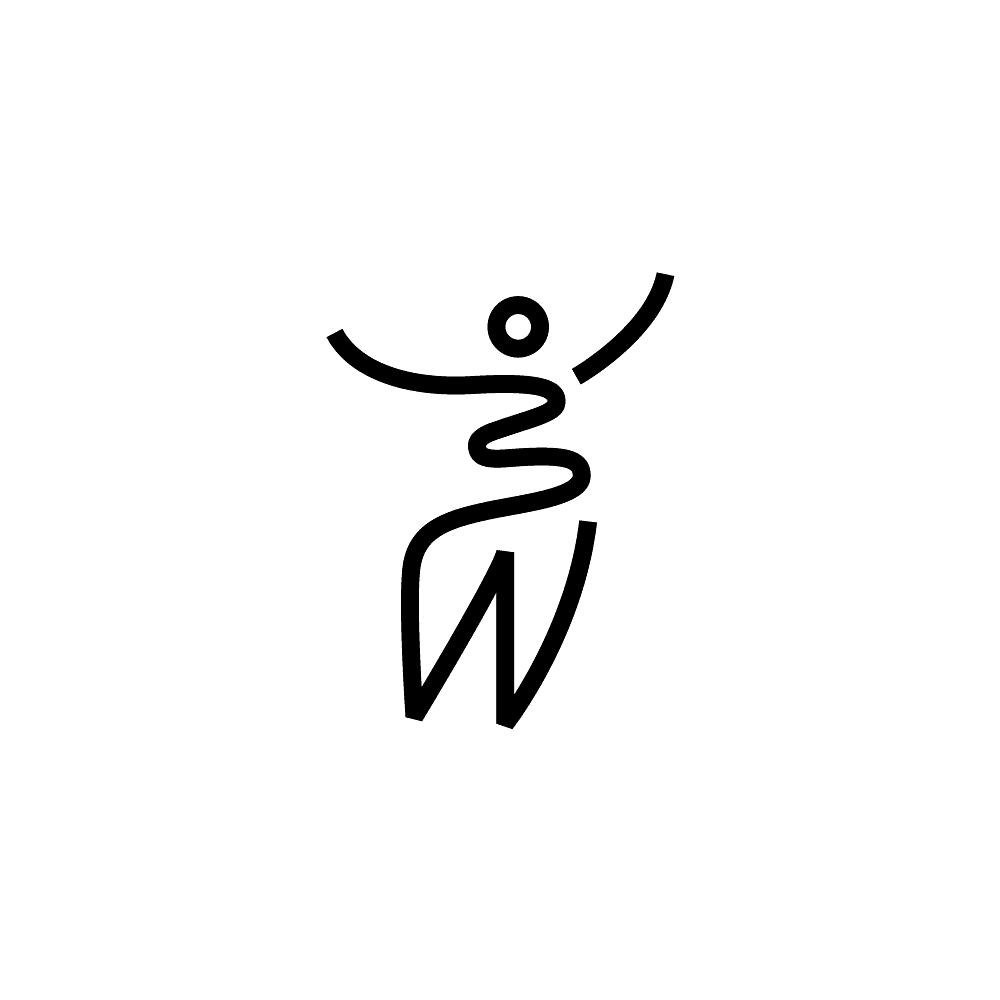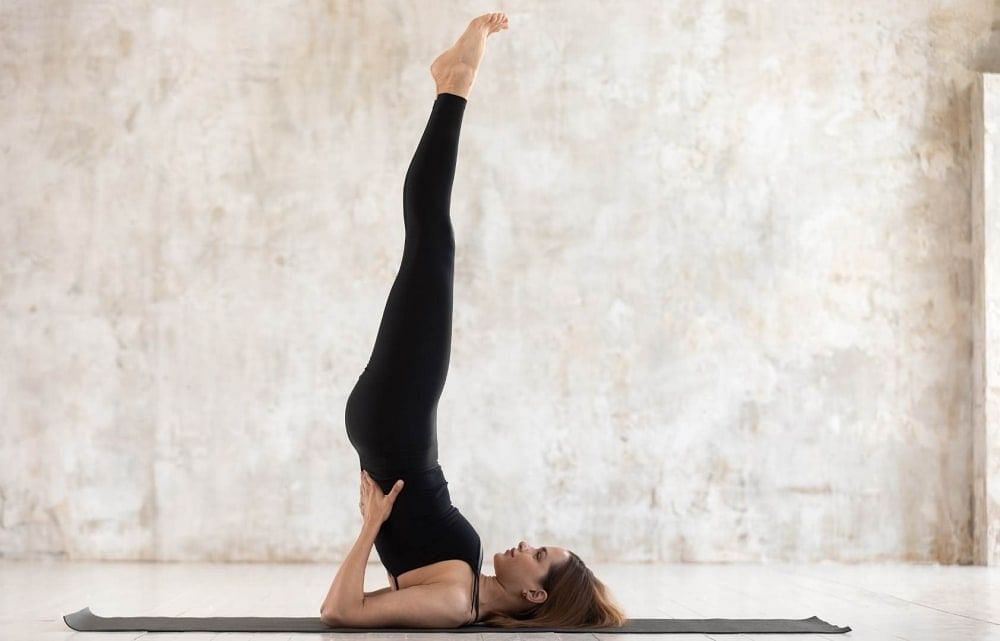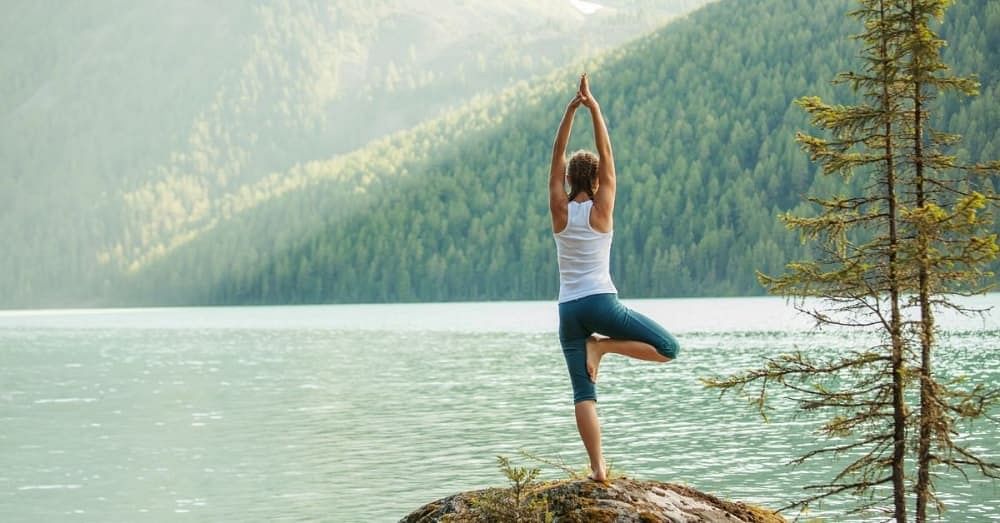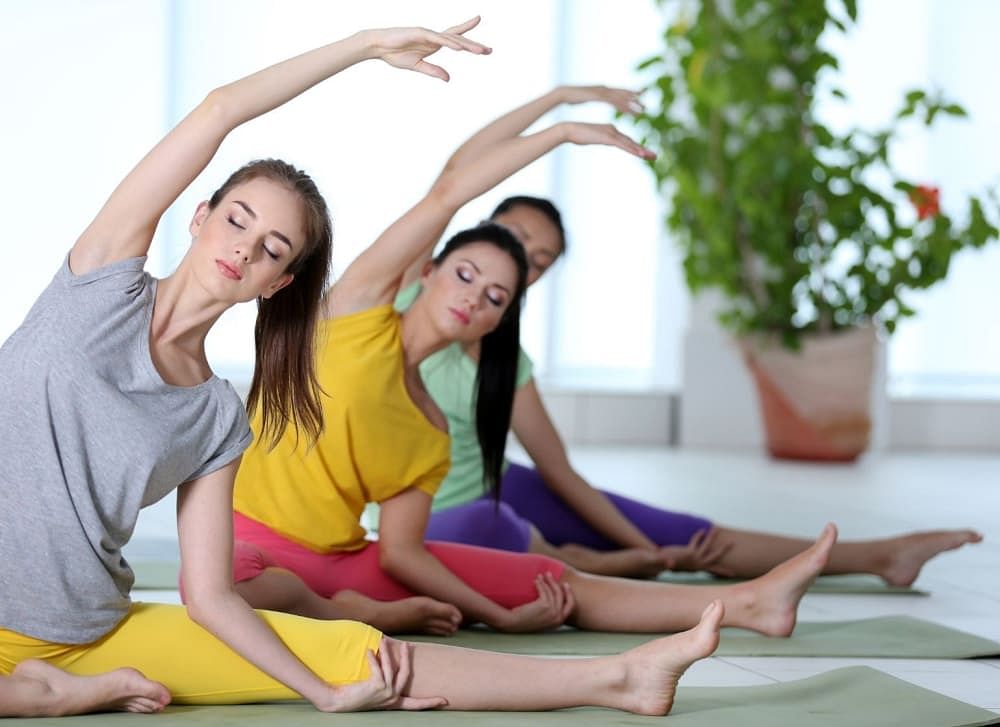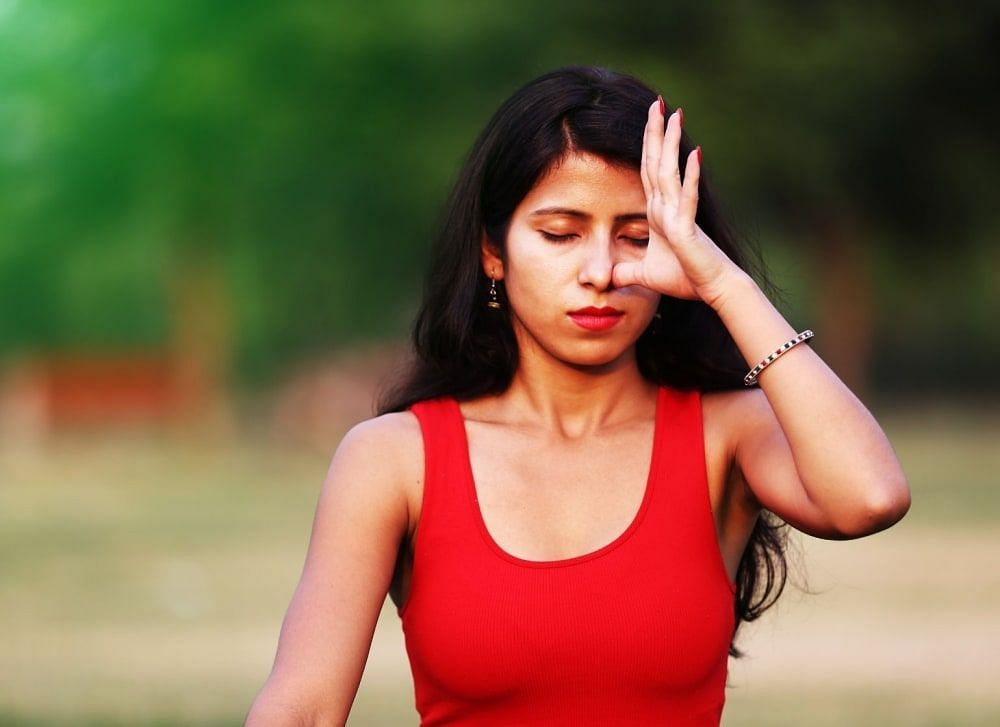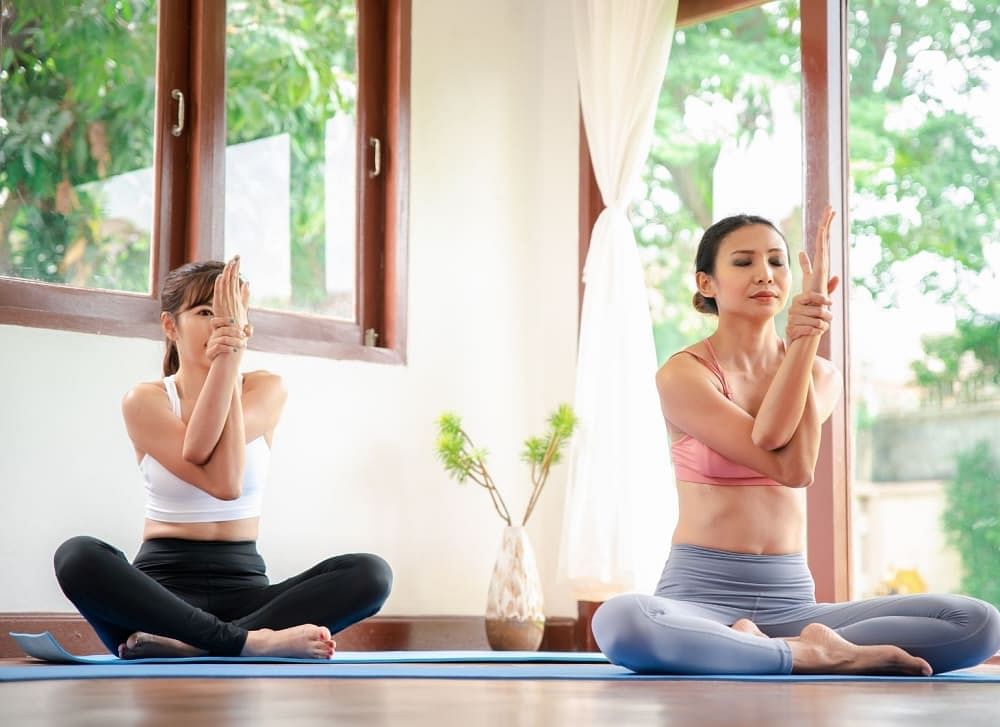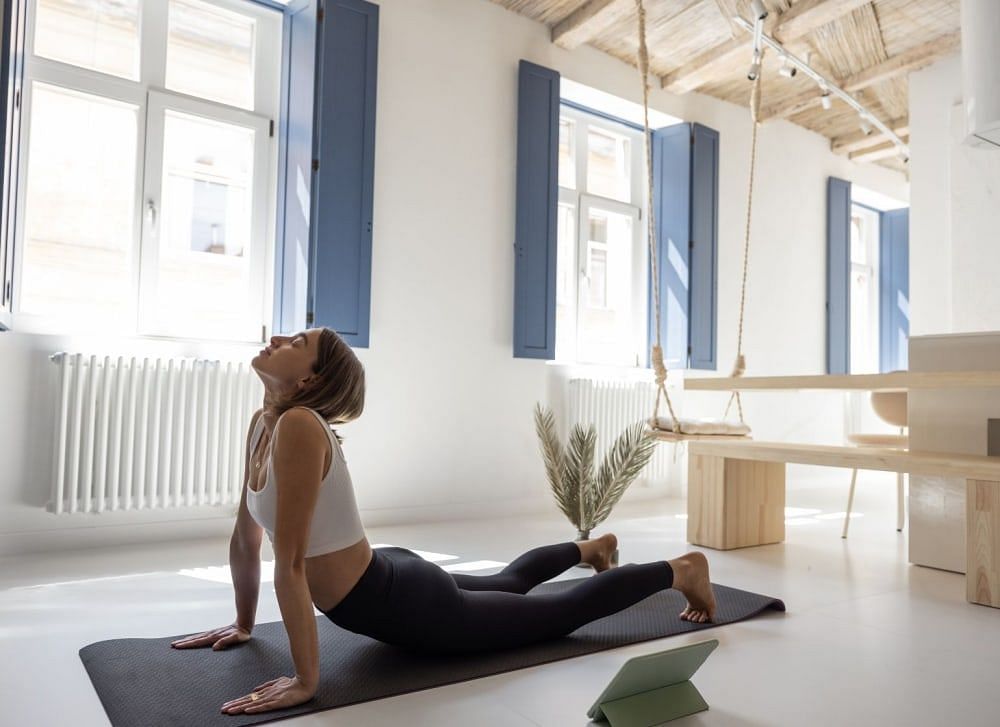Sarvangasana is one of the best asanas of Hatha yoga. It has a positive impact on the overall health of the body. It improves the body’s flexibility and strength while keeping the mind calm. The shoulder stand has all the benefits of a headstand but is easier and safer to perform.
What Is Sarvangasana (Shoulder Stand)?
Sarvangasana, popularly known as ‘Shoulder Stand,’ is a full-body exercise that stimulates different muscles of the body. In Sanskrit, sarv means whole, anga means body parts, and asana means posture.
It is also referred to as the ‘Queen of all the asanas’ as it helps the body both inside and outside. Regular practice of shoulder stand benefits our body by improving its flexibility and strength along with mental calm and peace.
In the shoulder stand pose, the whole body is balanced on the shoulder as a result of the direction of blood flow reverses. It promotes blood supply to the face, scalp, and brain.
After the pose, blood rushes backwards and benefits people with low blood pressure and aids in respiratory issues by increasing the blood flow in the lungs. It also helps in achieving better posture and balance.
Sarvangasana has two variations:
1) Salamba Sarvangasana: In this, the lower back is supported by hands in the inversion. It is also known as the supported shoulder stand pose.
2) Niralamba Sarvangasana: In this, the lower back is not supported by the hands. It is also known as an unsupported shoulder stand pose.
Sarvangasana Benefits
Sarvangasana benefits the physical and mental well-being of an individual. Regular practice of Sarvangasana gives:
1. Strength and Flexibility
Sarvanagasna enhances the flexibility of the spine. It strengthens the back, shoulder, and arms.
2. Lungs Capacity
As the shoulder stand improves the blood supply to the lungs, the lower part of the lungs becomes more strong and efficient. It thereby improves the lungs capacity.
3. Respiratory Problems
Shoulder stand benefits in curing asthma, sinusitis, and other respiratory problems. Toxins from the respiratory systems are drained, resulting in more oxygen supply to the organs.
4. Reproductive Health
Sarvangasana improves reproductive health by increasing the efficiency of reproductive organs in both men and women. It also relieves symptoms of menopause and balances the mood swings in women. It is found to be beneficial in conditions like syphilis and frequent abortions.
5. Gut Health
Digestive system is improved with drainage of stagnant blood and proper blood circulation. It cures constipation, indigestion, and other gut-related problems.
6. Weight Loss Management
With regular practice of Sarvangasana for the long term, body weight can be managed. It reduces the extra flap present around the stomach, tones the muscles of the abdomen, and gives core strength.
7. Blood Sugar Level
The shoulder stand benefits people with diabetes. It regulates blood sugar levels and manages insulin production.
8. Hormonal Balance
As the stagnant blood from the lower part of the body is drained to other body parts, the blood supply to the brain and hormonal glands increases. All the functions of the endocrine system (hormonal system) of the body are improved due to an increase in oxygen and blood supply to them. It stimulates the thyroid gland and regulates both low or high thyroid hormones.
9. Mental Health
Sarvangasana promotes good sleep at night. It also releases happy hormones like dopamine which results in relieving stress, anxiety, and depression. It helps in treating insomnia and mood disorders.
10. Functional Disorders
As the blood supply to the brain, eyes, nose, ears, and throat is increased, their overall functioning is improved. Sarvangasana benefits hair and skin.
11. Immunity
Sarvangasana boosts immunity. It also balances the circulatory, digestive, reproductive, and nervous systems of the body. Thus, they have a positive impact on the overall health of the body.
12. Other Ailments
Sarvangasana prevents and cures varicose veins. It releases pressure from anal muscles and relieves haemorrhoids (piles). The shoulder stand pose reduces water retention in the lower portion of the body. It also treats headaches and migraines.
As it has many health benefits, the uses of Sarvangasana are:
- The shoulder pose is helpful in treating stage 1 and stage 2 thyroid problems.
- It is useful in correcting indigestion and constipation.
- Sarvangasana helps in treating diabetes, varicose veins, haemorrhoids, and reproductive issues.
- The shoulder pose is useful in curing asthma, sinusitis, and respiratory problems.
- It is used to provide therapeutic benefits to cases of infertility.
- The shoulder pose helps in relieving headaches and migraines.
- It is useful in treating insomnia, mood swings, anxiety, and depression.
13. Sarvangasana Benefits for Hair
Sarvangasana benefits hair by enhancing blood circulation in the scalp. It:
- Promotes hair growth
- Reduces hair fall
- Provides nourishment to the hair follicles
14. Sarvangasana Benefits for Brain
The human brain controls all body functions and abilities, including cognitive thinking, feeling emotions, sensing, and all physical functioning of the body. Sarvangasana benefits the brain in many ways. It increases blood flow to the brain that:
- Provides more nourishment to the brain
- Makes the mind more alert
- Reduces anxiety and stress
- Improves self-confidence
- Improves blood supply to the hormonal glands located near the brain, such as the pineal gland and hypothalamus
- Stimulates the release of happy hormones like serotonin and dopamine
- Improves cognitive functioning of the brain
- Improves memory
- Relieves headache
- Brings mental calm and peace
15. Shoulder Stand Benefits for Skin
Sarvangasana is considered one of the best yoga poses for achieving healthy skin. It promotes blood circulation towards your face. The shoulder stand benefits for skin are:
- Treating dark circles
- Nourishing the skin and detoxifying the body
- Getting rid of pimples, wrinkles, acne, and dullness
- Improving skin texture and quality
- Anti-ageing effect on the skin and promoting youthfulness
- Improving the digestive process, which is essential to achieve healthy skin
16. Sarvangasana Benefits for Eyes
Eyes are our body’s window to the world. Today most people have one or more eye-related problems. It is either due to mobile phones or TV screens. Also, when we close our eyes, we feel relaxed, which shows the deep connection between the eyes and the mind. A healthy diet and sleep are not enough to take good care of your eyes. Yoga helps in improving the functioning of the eyes. One such effective yoga pose is Sarvangasana.
Sarvangasana benefits the eyes in many ways. It:
- Promotes blood flow towards the eyes and supports overall eye health
- Helps in correcting functional disorders of the eyes
- Improves eyesight
- Eases eye muscles
- Reduce eye tension
Setu Bandha Sarvangasana Benefits
Setu Bandha Sarvangasana is a simple posture that will help you to prepare for Sarvangasana. It is a relatively simple pose where you have to lift your hips, keeping the upper arm and feet on the floor. Setu Bandha Sarvangasana benefits the body’s physical and mental health. It:
1) Stimulates abdominal organs, thyroid gland, and lungs
2) Stretches neck, spine, chest, and hips
3) Relieves from headaches, backaches, stress, and anxiety
4) Improves digestion and blood circulation
5) Reduces fatigue
6) Strengthens back and buttocks
7) Relieves the symptoms of menopause
8) Treats high blood pressure, asthma, and sinus infections
Sarvangasana Steps
Sarvangasana should be performed on an empty stomach or 4-6 hours after taking the meal. It can be performed in the morning or the evening. The procedure of Sarvangasana should be followed cautiously and under the supervision of an expert.
Before starting, it is advised to prepare your body by stretching up your muscles. You can do simple neck and lower back exercises or do yoga poses like tadasana or halasana. It will also remove spine stiffness.
In the beginning, one should start with Ardha-Sarvangasana or half-shoulder stand pose. Here are Ardha-Sarvangasana steps that should be followed carefully:
Step 1: Lie down on your back, keep your hand by sides close to the body and feet together.
Step 2: Take full breaths and keep the mind calm.
Step 3: Fold the legs against the thighs and feet close to the hips.
Step 4: Raise the lower body vertically and support it by the hands in a way that fingers should be under the hips and thumb above.
Step 5: Maintain the position as long as you are comfortable. Do not strain yourself and try to achieve balance while exhaling the breath.
Step 6: Inhale and return to starting position by slowly lowering the hips supported by the hands.
Step 7: Take deep breaths and relax for a few minutes.
Here are Sarvangasana steps that should be followed carefully and under the guidance of a yoga expert:
Step 1: You should start by lying down on your back with hands sideways close to your body and feet together.
Step 2: Slowly lift your legs, back, and buttocks together and support your back with your hands.
Step 3: Keep the elbows close to each other. Do not support your body weight by your head or neck. It should be supported by the upper arms and shoulders.
Step 4: Keep your legs straight and firm and bring the toes straight over your nose. Your entire body up to shoulder should be in a straight line with arms supporting the back.
Step 5: Breathe normally and take care of your neck. Don’t press it over the floor.
Step 6: Maintain the position, begin with 10 seconds and take deep breaths.
Step 7: If you start feeling the strain, bring down your knees to the forehand and lower your legs slowly with the support of your hands.
Step 8: Take a few deep breaths and relax for a minute to breathe normally.
Preparatory poses that should be done before Sarvangasana are:
- Halasana or Plough Pose
- Viparita karni
- Setu Bandha Sarvangasana or Bridge Pose
- Dwi pada uttanpadasana
- Virasana or Warrior Pose
Follow-up poses that should be done after Sarvangasana are:
Sarvangasana Time Duration
If you are a beginner, you should try to maintain the pose for 30 seconds. Once you start getting comfortable with it and achieve better balance, you can increase the time duration by 10 seconds every day.
After a few weeks, try to maintain a shoulder stand pose for 1-2 minutes. Do not overstrain yourself and slowly increase your hold every day by 5-10 seconds. After mastering the posture, you can hold it for up to 2-3 minutes.
Sarvangasana time duration should be a minimum of 20 seconds at the beginning and 5 minutes at the most.
Sarvangasana (Shoulder Stand) of Do’s and Don'ts
Do’s
- In the beginning, try it under the guidance of an expert.
- Pay attention to the neck. If not done correctly, it can cause neck injury.
- You can start your practice by resting against the wall or any solid object until the perfect balance is secured.
- Attempt Sarvangasana in parts. Do full posture after a few weeks of initial training.
- Try to raise your trunk vertically enough to let your chin rest against the chest.
- Great care should be taken to avoid any strain or jerk as it is a low-head posture.
- Take ample support of your arm.
- Do it slowly and calmly.
- It is difficult to perform, so you can start it by first posing in Halasana. It will stretch the thigh and hip muscles and give momentum to the body to lift off the ground.
- Sarvangasana is an inward bending body pose. It should be followed by backward bending poses like Bhujangasana (cobra pose) or Matsyasana (fish pose).
Don’ts
- Sarvangasana, if attempted in a hurry, can cause unnecessary pressure on the heart and respiratory organs. It can lead to discomfort and can cause enlargement of the blood vessels of the head.
- Do not attempt Sarvangasana after heavy gymnastics. It disrupts blood circulation and causes a heavy blood rush to the brain. It is harmful to brain health.
- Do not practice it beyond 2 minutes at once. Relax in between and do not attempt it for more than 5 minutes a day. It can prove injurious in longer durations.
- Don’t bend the knees while doing the pose.
- Do not tense your legs as it prevents drainage of blood.
- It is advised not to raise your head from the floor.
- Don’t point your toes as it prevents blood drainage.
- Don’t get up instantly after finishing the shoulder stand pose.
- Do not practice shoulder stands when you have shoulder, wrist, or neck pain or injury.
- Women should avoid it during menstruation and pregnancy.
- Older people should not practice shoulder stand pose.
Sarvangasana (Shoulder Stand) Contraindications
If not done carefully, Sarvangasana side effects include:
- Injury to neck and spine
- Pain in shoulder and upper arms
- Abnormal blood rush to the brain leading to discomfort and dizziness
- Negatively affect the weak eye blood vessels and worsen the condition of glaucoma
- In women, if it is performed during menstruation can lead to excess bleeding
There are certain medical conditions in which doing a shoulder stand can cause more harm than good. Sarvangasana contraindications are:
- Slip disc
- Acute thyroid problem
- Enlarged thyroid
- Enlarged liver or spleen
- Spondylosis
- High blood pressure
- Neck, shoulder or back injury
- Heart problems
- Brain ailments
- Weak blood vessels in the eye
- Glaucoma
- High myopia
- Pregnancy
- Menstruation
If you have the above-mentioned condition, do not attempt Sarvangasana without the advice of your consulting physician.
Summing Up on Sarvangasana Benefits
Sarvangasana is an inversion pose that improves blood supply to the brain. Shoulder stand benefits the entire body and keeps the mind calm.
Since it is difficult to pose in the beginning, it should be done under supervision or against the wall. You can hold the posture for 2-3 minutes once you master it.
Sarvangasana benefits include relieving headaches, constipation, stress, and depression. It cures insomnia, diabetes, asthma, and respiratory problems.
It improves body posture and enhances the cognitive abilities of our brain. It balances the body hormones and has a positive impact on the digestive, reproductive, circulatory, and nervous systems of the body.
FAQs
1) How Many Times We Should Do Sarvangasana?
One minute of Sarvangasana in the morning and one minute of Sarvangasana in the evening is enough to keep you healthy. You can maintain the pose for a longer duration, but not more than 5 minutes.
2) What Happens During Sarvangasana?
During Sarvangasana, the blood supply in the body reverses, and the stagnant blood present in the legs and lower body moves towards the face, scalp, and brain. It improves the functioning of the brain and has a positive impact on skin and hair health.
Not only this, it enhances blood supply to the lungs, which increase lung capacity and treat respiratory disorders. It also improves flexibility and strengthens shoulders, upper arm, and back.
3) Can Sarvangasana Be Done During Periods?
No, Sarvangasana should not be done during periods as it requires inverting the body. It should be avoided during periods as it can induce heavy bleeding and vascular obstruction problems. One should practice yoga poses that improve menstrual health without upsetting the body, like Balasana, Dandasana, Kumbhakasana (Plank pose), or Paschimottanasana.
4) Can We Do Sarvangasana in the Evening?
Yes, Sarvangasana can be performed in the evening. Do it cautiously and under the supervision of an expert.
References
- D Konar, R Latha, November 2000; Cardiovascular response to head down- body-up postural exercise (Sarvangasana) - https://www.researchgate.net/publication/12115858_Cardiovascular_response_to_head_down-_body-up_postural_exercise_Sarvangasana
- Arkiath Veettil Raveendran, Anjali Deshpandae, September 2018; Therapeutic Role of Yoga in Type 2 Diabetes - https://www.ncbi.nlm.nih.gov/pmc/articles/PMC6145966/
